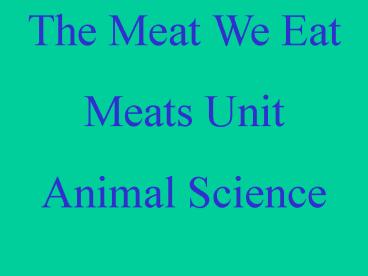The Meat We Eat - PowerPoint PPT Presentation
1 / 29
Title:
The Meat We Eat
Description:
Beef: the meat from mature bovines that are generally over 12 months of age. ... Mutton: the meat from mature ovine carcasses that fail to show a break joint on ... – PowerPoint PPT presentation
Number of Views:182
Avg rating:3.0/5.0
Title: The Meat We Eat
1
The Meat We Eat Meats Unit Animal Science
2
Terminology
3
Terminology Meats the edible flesh of mammals
used for food
4
Poultry the edible flesh of poultry used for food
5
Beef the meat from mature bovines that are
generally over 12 months of age.
6
Veal the meat from very young calves, usually
less than 3 months of age.
7
Mutton the meat from mature ovine carcasses that
fail to show a break joint on the front foreleg.
8
Lamb meat from lambs or young sheep,up to about
one year of age that shows a break joint in the
foreleg.
9
Pork meat associated with all ages of hog
carcasses.
10
Chevon meat from mature goats.
11
Cabrito meat from young goats.
12
Cabrito meat from young goats.
13
Meat Inspection
14
The Meat Inspection Division of the USDA was
created in 1906.
15
Inspectors are civil service veterinarians or
non-professional lay inspectors. All are
government employees, meaning the program is
financed by the public.
16
The federal government requires supervision of
establishments which slaughter, pack, render, and
prepare meats and meat products for interstate
shipment and foreign export. Individual states
have responsibility for intrastate shipments,
however state standards cannot be lower than
federal levels.
17
The purpose of inspection is a. Safeguard the
public by eliminating disease or otherwise
unwholesome meat from the food supply. b. To
enforce the sanitary preparation of meat and meat
products.
18
The purpose of inspection is c. To guard
against the use of harmful ingredients or residue
in meats from drugs, growth promotants,
pesticides, etc. d. To prevent the use of false
or misleading names or statement labels.
19
The Wholesome Meat Act of 1967 updated and
strengthened the Meat Inspection Act of 1906.
20
A. States were given the option of conducting
their own inspection service or turning the
responsibility over to the federal government. B.
Most states simply apply the federal regulations
to their own programs.
21
Types of Inspection
22
Antermortem inspection is made in pens or as
animals are moved from the scales after weighing
obviously diseased or otherwise unhealthy
animals not fit for human consumption may be
marked Suspect or Condemned.
23
Postmortem inspection is made at the time of
slaughter and includes careful examination of the
carcass and viscera (internal organs) all good
carcasses are stamped U.S. Inspected and
Passed. Those failing inspection are stamped
U.S. Inspected and Condemned.
24
Regulations do not apply to farm slaughter.
25
Inspection vs. Grading
26
Inspection a. is required. b. is objective.
27
Grading a. is optional. b. is subjective.
28
Types of Grading
29
Grading a. Quality Grading. b. Yield Grading.

